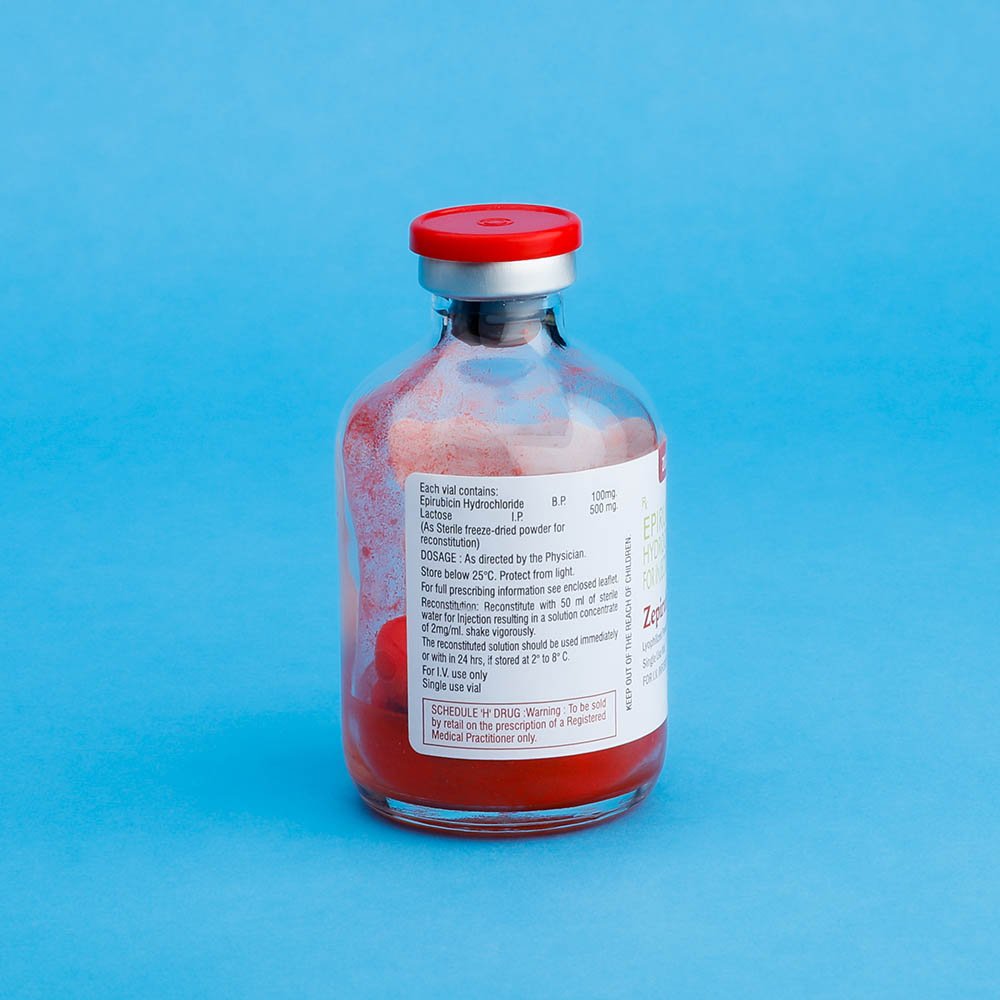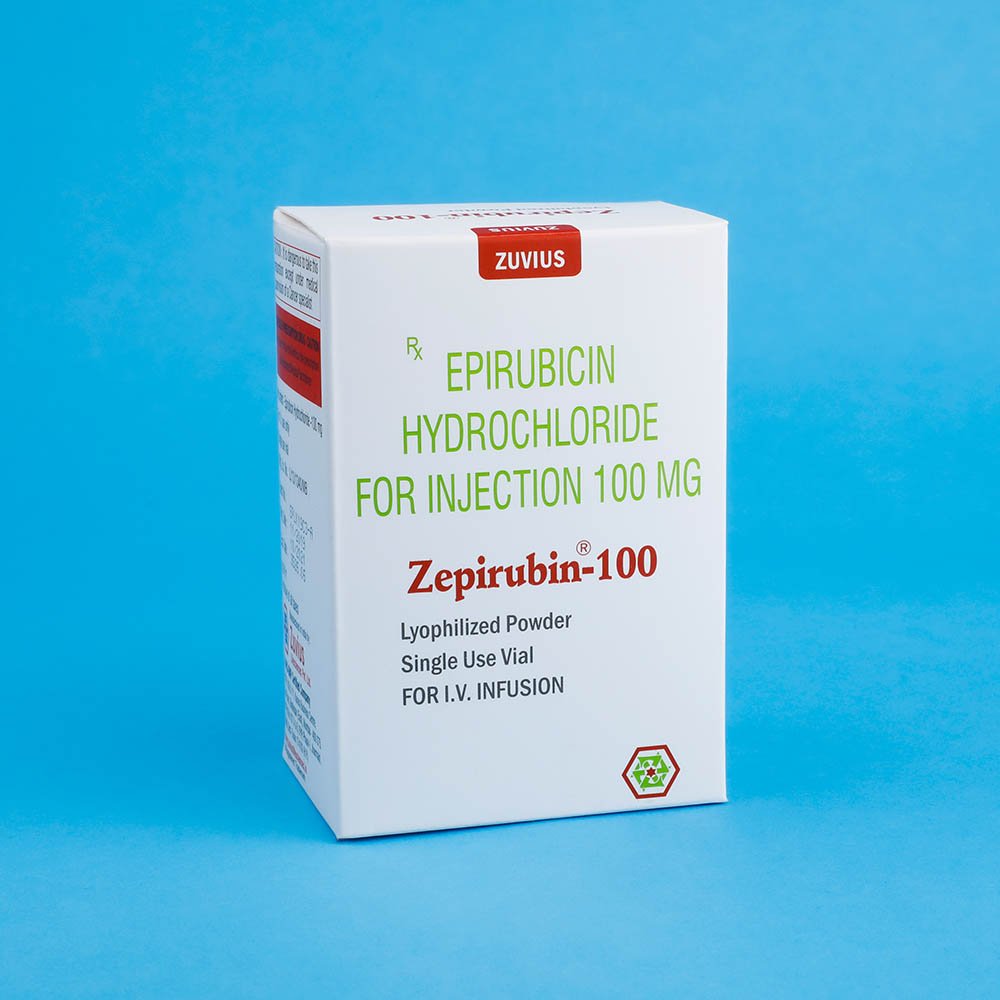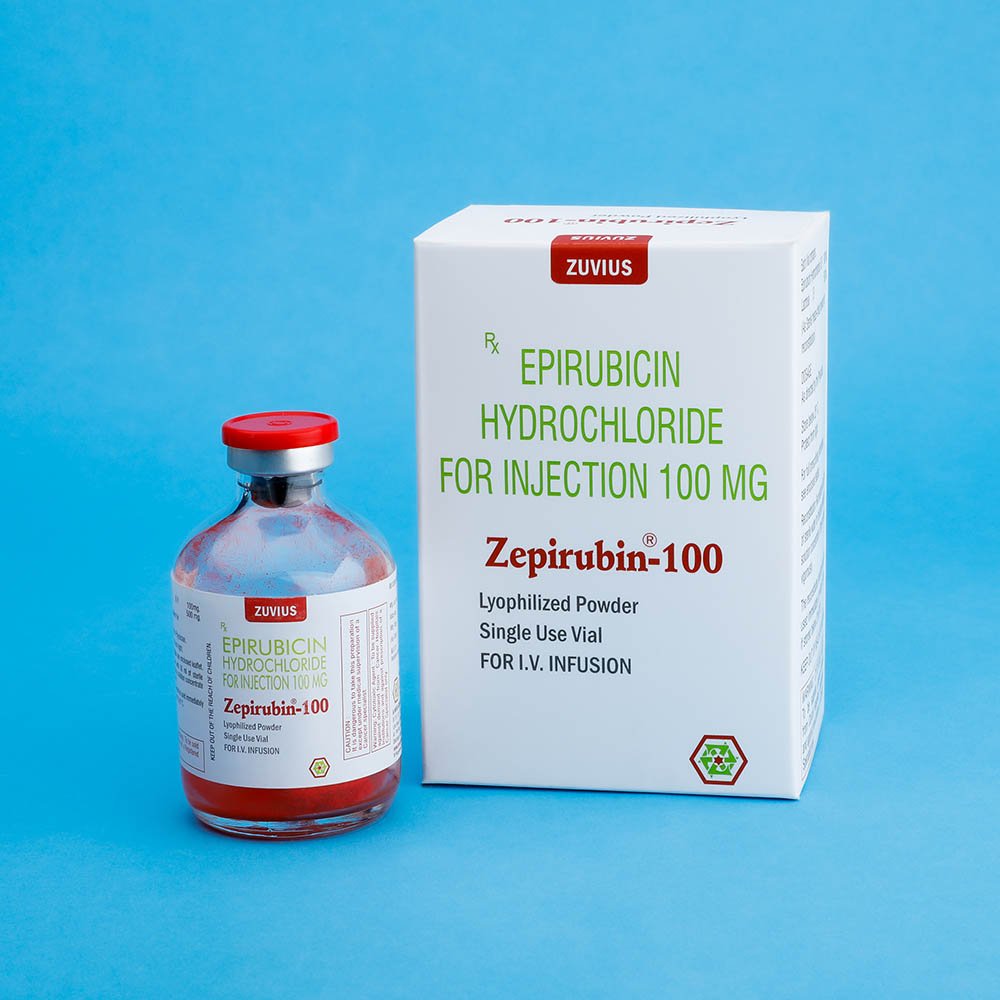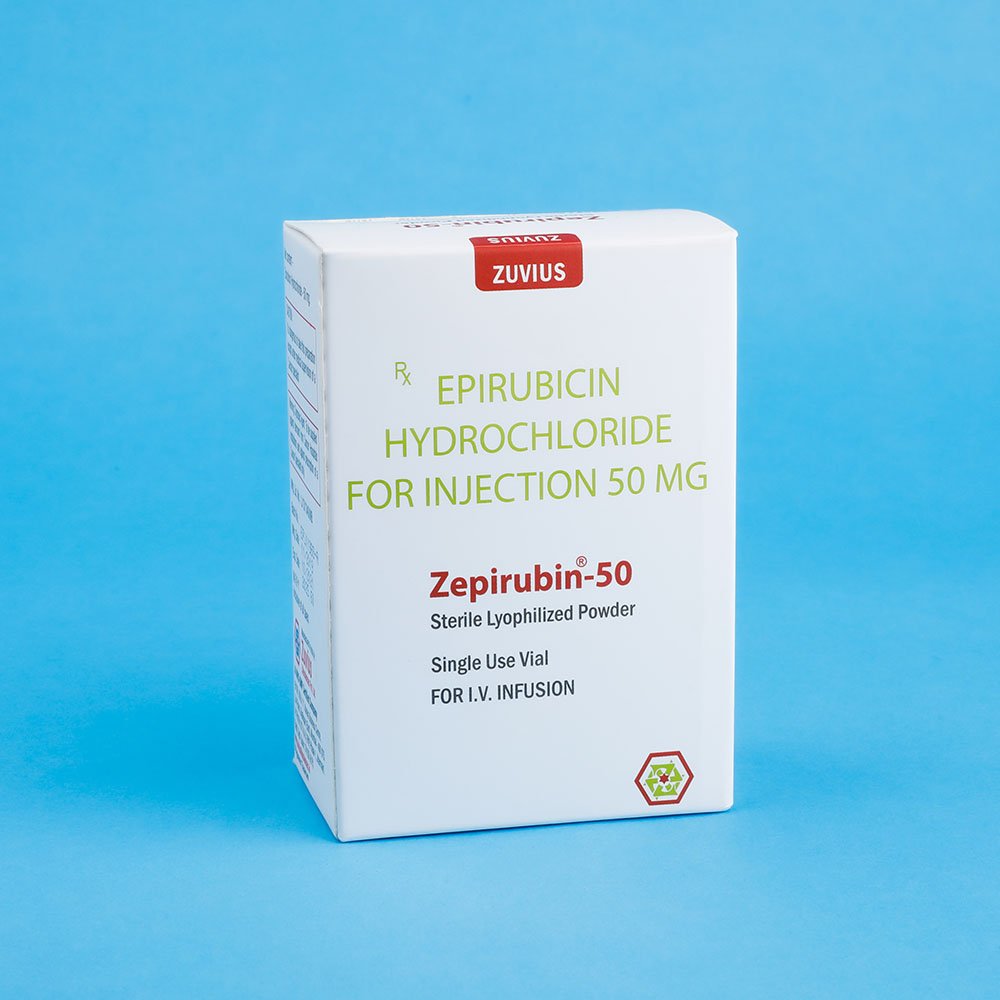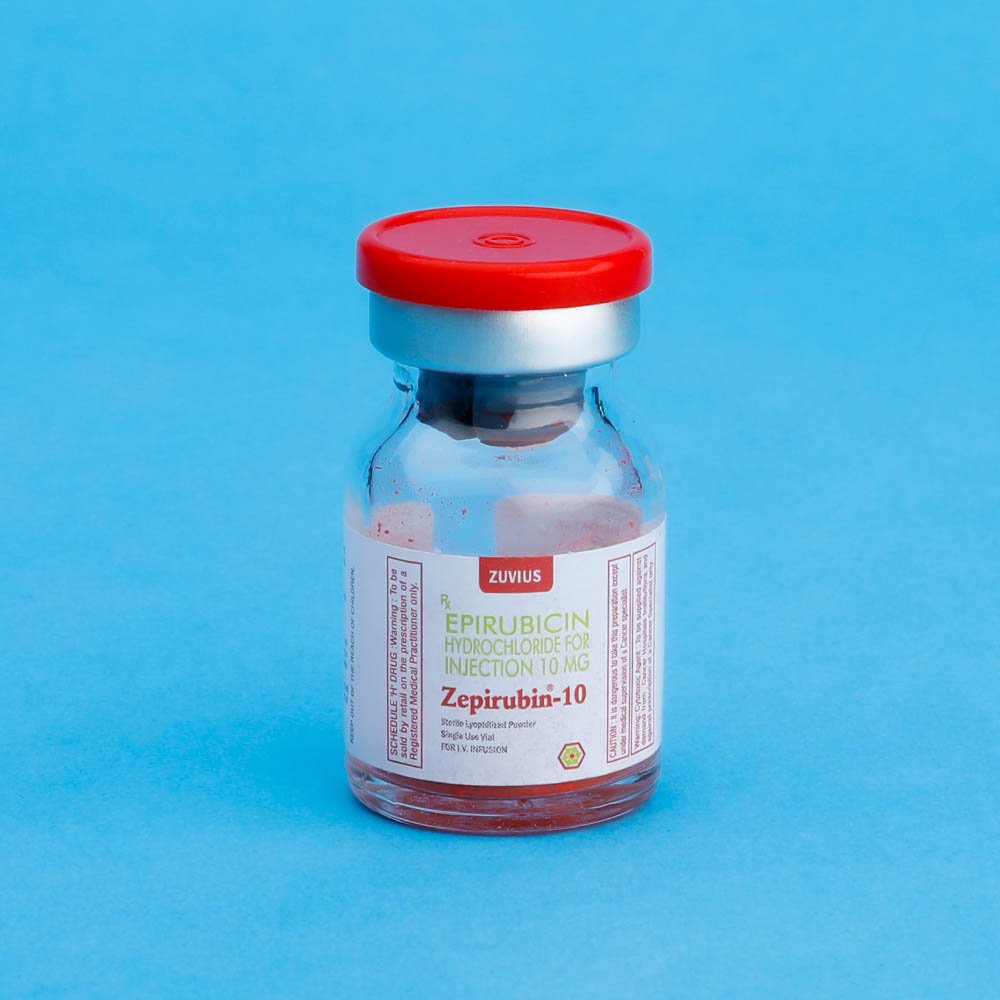Zepirubin- Epirubicin Inj
Epirubicin
Strength: 10mg / 50mg / 100mg
Pack Size: 1 vial
Drug Class: Anthracyclines and related substances
Dosage and Administration:
When Epirubicin is used as a single agent, the recommended dosage in adults in 60-90 mg/m2 body area : the drug should be indicated I.V. over 3-5 minutes and depending on the patients haematomadullar status, the dose should be repeated at 21 day intervals. Lower doses (60-75 mg/m2) are recommended for the patients whose bone marrow function has already been impaired by the previous chemotherapy or radio-therapy, by age, or neoplastic bone-marrow infiltration. The total dose per cycle may be divided over 2-3 successive days. When the drug is used in combination with other antitumor agents. the doses need to be adequately reduced. Since the major route of elimination of Epirubicin is the hepatobilary system, the dosage should be reduced in patients with impaired liver function, in order to avois an increase of overall toxicity. Moderate liver impairment (bilirubin : 1.4-3 mg/100 ml of BSP renton : 9-5%) requires a 50% reduction of dose while severe impairment (bikirubin>3mg/100 ml or BSP rention>15%) necessitates a dose reduction of in view of the limited amount of Epirubin excreted by this route.
DIRECTIONS FOR ADMINISTRATION
Epirubicin should be administered by intravenous injection. It is not active when given orally and should not be injection intramuscullarly or intrathecally. It is advisable to give the drug via the tubing of a freely running i.v. saline infusion after check that the needle is well placed in the vein. This method minimizes the risk of drug extravasation and makes sure that the vein is flushed with saline after the administration of the drug. Extravasaton of Epirubicin rapid dissolution from the vein during injection may given rise to severe tissue lesions, even necrosis. Venous sclerosis into the same vein. Epirubicin rapid dissolution should not be mixed with heparin due to chemical incompatibility which may lead to precipitation when the drug are in certain proportions. Epirubicin rapid dissolution can be used in combination with other antitumour agents, but is not recommended that it is mixed with these drugs in the same syringe.
PREPARATION KF INFUSION SOLUTION
Zepirubin 10 mg should be reconstituted to 5 ml by adding sterile water for injection I.P. and used before 24 hours after preparation. Zepirubin 50 mg should be reconstituted to 25 ml by adding sterile water for injection I.P. and use before 24 hours after preparation. Intravenous administration of Epirubicin HCI should ? be performed with caution. It is recommended that Epirubicin HCI be administered into the tubing of a freely flowing intravenos infusion (0.9% Sodium Chloride or 5% Glucose solution) over a period of 3-5 minutes. The technique is intended to minimize the risk of thrombosis or peruvians extravasation. A direct push injection is not recommended due to the risk of return needle aspiration. Venous sclerosis may result from injection into small vessels or repeated injection into the same vein (see PRECAUTIONS). Beside above regimens. Several other protocols has been discussed in different published articles.
Cold Storage: no
Epirbicin is an anthracycline cytotoxic agent and forma a complex with DNA by interacalation of its planar rings between nucleotide base pairs, with consequent inhibition of nucleic acid (DNA & RNA) and protein synthesis, Such intercalation triggers DNA cleavage by topoisomerase II, resulting in cytocidal activity, Epirubicin also inhibits DNA helicase activity, preventing the enxymatic seperation of double – standard DNA & interfering with replication and transcription. Epirubicin is also involved in oxidation/reduction reactions by generating cytotoxic free radicaEpirbicin is an anthracycline cytotoxic agent and forma a complex with DNA by interacalation of its planar rings between nucleotide base pairs, with consequent inhibition of nucleic acid (DNA & RNA) and protein synthesis, Such intercalation triggers DNA cleavage by topoisomerase II, resulting in cytocidal activity, Epirubicin also inhibits DNA helicase activity, preventing the enxymatic seperation of double – standard DNA & interfering with replication and transcription. Epirubicin is also involved in oxidation/reduction reactions by generating cytotoxic free radicals.
Epirubicin Hcl Injection is indicated as a component of adjuvant therapy in patients with evidence of axillary node tumor involvement following resection of primary breast cancer.
Renal Function
Serum creatinine should be assessed before and during therapy. Dosage adjustment is necessary in Patients with serum creatinine >5mg. / dL. See (a DOSAGE AND ADMINISTRATION). Patients undergoing Dialysis have not been studied.
Tumor-Lysis Syndrome As with other cytotoxic agents. Epirubicin HCI may induce hyperuicemia as a consequence of the extensive purine catabolism that accompanies drug-induced rapid lysis of highly chemosensitive neoplastic cells (tumors lysis syndrome). Other metabolic abnormalities may also occur. While not generally a problem in patients with breast cancer., physicians should consider the potential for tomor-lysis syndrome on potentially susceptible patients and should consider monitoring serum uric acid, potasssium, calcium, phosphate and creatining immediately after initial chemotherapy administration. Hydration, urine alkalinization and prophylaxis with allopurinol to prevent hyperuricemia may minimize potential complications of tumor-lysis syndrome.
Epirubicin has been extensively investigated in patients with breast cancer and has been found to be a highly effective agent, both for the treatment of patients with metastatic disease and as an adjuvant therapy.
- General Epirubicin HCI injection is administered by intravenous infusion. Venous sclerosis may result from an injection in to a small vessel or from repeated injections in to the same vein. Extravasation of Epirubicin during the infusion may cause local pain, severe tissue lesions and necrosis. It is recommended that Epirubicin HCI be slowly administered in to the tubing of a freely running intravenous infusion. If possible, veins over joints or in extremities with compromised venous orlymphatic drainage should be avoided. The dose should be administered over 3-5 minutes. A burning or stinging sensation may be indicative of perivenous infiltration and the infusion should be immediately terminated and restarted in another vein. Penvenous infiltration may occur without causing pain. Facial flushing as well as local erythemaous streaking along the vein, may be indicative of excessevely rapid administration. It may precede local phlebits or thrombo phelbitis. Patients administered the 120 mg/m2 regimen of Epirubicin Hcl as a component of combination chemotherapy should also receive prophylactic antibiotic with trimethoprim sulfamethaxazole.LABORATORY TESTSBlood counts, including absolute neutrophill counts and liver function should be assessed before and during each cycle of therapy with Epirubicin.Repeated evaluations of LVEF Should be performed during therapy. See WARNINGS Drug /Laboratory test interactions There are known interactions between Epirubicin HCI and Laboratory tests.Carcinogenesis, Mutagenesis and Impairment of Fertility Treatment related acute myelogenous leukemia has been reported in women treated with Epirubicin based adjuvant chemotherapy regimens (see WARNINGS Secondary leukemia). Conventiona lalong term animal studies to evaluate the carcinogenic potential data are not available. Epirubicin HCI could induce chromosomal damage in human spernatozoa due to its genotoxic potential Men undergoing treatment with Epirubicin HCI should use effectiveContraceptive methods. Epirubicin HCI may cause irreversible amenorrhea (Premature menopause) in premenopausal women. Pregnancy category D Epirubicin HCI may cause fetal Harm When administered to a pregnant woman. Administration of 0.8 mg/kg/day intravenously of Epirubicin to rats (About 0.04 times the maximum recommended single human ?dose on a body surface area basis) during days 5-15 of gestation was embryotoxic (increased resorption and post implantation loss) and caused fetal harm when administered to a pregnant woman. Administration 2 mg/kg/day intravenously of Epirubicin to rats (about 0.1 times the maximum recommended single human dose on body surface area basis) on days 9 and 10 of gestation was embryotoxic (increase late resorptions post implanations lossed and dead fetuses and decreased live fetuses), retarded fetal growth (decreased body weight) and caused decreased placental weight, This dose was also teratogenic, causing numerous external (anal tresia, misshapen tall, abnormal genital tubercle) visceral (primarily gastrointestinal, urinary and cardiovascular systems) and skeletal (deformed) long bones and gridles, rib abnormalities, irregular spinal ossification) malformations.Administration of intravenous Epirubicin to rabbits at dose up to 0.2 mg/kg/day (about 0.02 times the maximum recommended single human dose on a body surface area basis) during days 6 to 18 of gestation was not embryotoxic, but meternally toxic dose of 0.32 mg/kg day increased abortion and delayed ossification. Administration of a meternally toxic intravenous dose of 1 mg / kg/day Epirubicin to rabbits
This medicine may increase your risk of developing blood clots. If you have chest pain, trouble breathing, or pain, redness, or swelling in your arms or legs while using this medicine, call your doctor right away. This medicine may turn your urine red for 1 or 2 days after your treatment.


